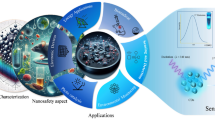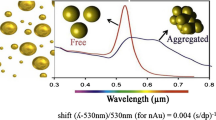Abstract
Six different sensors were prepared using hydrolytic and non-hydrolytic sol–gel routes and three different pH indicators as receptor elements. These materials were employed as dual-target sensors for ammonia gas sensing and pH measurements in real samples. Ultraviolet–visible diffuse reflectance spectroscopy and a colorimetric analysis were used to evaluate the pH transitions and the color change that resulted from the ammonia that was employed as a probe for gas sensing. The colorimetric analysis was performed using the CIELAB color space model with the D65 standard illuminant. The resulting \( \Updelta {\text{E}}_{\text{ab}}^{*} \) values correlated with the response time for the observation of the first visible color change detected by the human eye (N = 50), and the average time values ranged from 48 to 117 s. In addition, the response times were evaluated as a function of sample characteristics, namely, the gender, age and eye color. Only groups of these characteristics exhibited relevance to the response time and could be associated with a specific range of time. The sensors were also employed for pH measurements of an aqueous solution, and a double-color scale could be established both with the sensors synthesized by the acid route and with the pH indicators alizarin red and brilliant yellow. From this color scale, it was possible to identify a shift in the turning point of the pH indicator from the free molecule to the encapsulated molecule. The double-color scale was applied to evaluate real samples from a galvanic industry using the synthesized encapsulated sensors.





Similar content being viewed by others
References
Eggins BR (2002) Chemical sensors and biosensors. Wiley, Chichester
Wolfbeis OS, Reisfeld R, Oehme I (1996) Sol-gels and chemical sensors, vol 85. Structure and Bonding. Springer, Berlin
Walcarius A, Collinson MM (2009) Analytical chemistry with silica sol-gels: traditional routes to new materials for chemical analysis. In: Yeung ES, Zare RN (eds) Annual review of analytical chemistry, vol 2. Annual review of analytical chemistry. Annual reviews, Palo Alto, pp 121–143 doi:10.1146/annurev-anchem-060908-155139
Jurmanovic S, Kordic S, Steinberg MD, Steinberg IM (2010) Organically modified silicate thin films doped with colourimetric pH indicators methyl red and bromocresol green as pH responsive sol-gel hybrid materials. Thin Solid Films 518(8):2234–2240
Chen HX, Wang XD, Song XH, Zhou TY, Jiang YQ, Chen X (2010) Colorimetric optical pH sensor production using a dual-color system. Sens Actuator B-Chem 146(1):278–282
Capeletti LB, Bertotto FL, Dos Santos JHZ, Moncada E, Cardoso MB (2010) The effect of the sol-gel route on the characteristics of acid-base sensors. Sens Actuators B 151(1):169–176
Wencel D, MacCraith BD, McDonagh C (2009) High performance optical ratiometric sol-gel-based pH sensor. Sens Actuator B Chem 139(1):208–213
Dong SY, Luo M, Peng GD, Cheng WH (2008) Broad range pH sensor based on sol-gel entrapped indicators on fibre optic. Sens Actuator B Chem 129(1):94–98. doi:10.1016/j.snb.2007.07.078
Jeronimo PCA, Araujo AN, Montenegro M (2007) Optical sensors and biosensors based on sol-gel films. Talanta 72(1):13–27
Kowada Y, Ozeki T, Minami T (2005) Preparation of silica-gel film with pH indicators by the sol-gel method. J Sol-Gel Sci Technol 33(2):175–185
Fairchild MD (2005) Color appearance models, 2nd edn. Wiley, England
Laborie B, Vienot F, Langlois S (2010) Methodology for constructing a colour-difference acceptability scale. Ophthalmic Physiol Opt 30(5):568–577. doi:10.1111/j.1475-1313.2010.00765.x
Zhang C, Suslick KS (2007) Colorimetric sensor array for soft drink analysis. J Agric Food Chem 55(2):237–242. doi:10.1021/jf0624695
Lapresta-Fernandez A, Huertas R, Melgosa M, Capitan-Vallvey LF (2009) Colourimetric characterisation of disposable optical sensors from spectroradiometric measurements. Anal Bioanal Chem 393(4):1361–1366. doi:10.1007/s00216-008-2552-4
Melendez-Martinez AJ, Vicario IM, Heredia FJ (2003) Application of tristimulus colorimetry to estimate the carotenoids content in ultrafrozen orange juices. J Agric Food Chem 51(25):7266–7270. doi:10.1021/jf034873z
Yang HW, Hua MY, Liu HL, Tsai RY, Chuang CK, Chu PC, Wu PY, Chang YH, Chuang HC, Yu KJ, Pang ST (2012) Cooperative Dual-Activity Targeted Nanomedicine for Specific and Effective Prostate Cancer Therapy. ACS Nano 6(2):1795–1805. doi:10.1021/nn2048526
Won YW, Yoon SM, Lim KS, Kim YH (2012) Self-assembled nanoparticles with dual effects of passive tumor targeting and cancer-selective anticancer effects. Adv Funct Mater 22(6):1199–1208. doi:10.1002/adfm.201101979
Arns S, Gibe R, Moreau A, Morshed MM, Young RN (2012) Design and synthesis of novel bone-targeting dual-action pro-drugs for the treatment and reversal of osteoporosis. Bioorg Med Chem 20(6):2131–2140. doi:10.1016/j.bmc.2012.01.024
Capeletti LB, dos Santos JHZ, Moncada E (2011) Quantification of indicator content in silica-based pH solid sensors by diffuse reflectance spectroscopy. Anal Methods 3(10):2416–2420. doi:10.1039/c1ay05235g
Yeboah SA, Wang SH, Griffiths PR (1984) Effect of pressure on diffuse reflectance infrared-spectra of compressed powders. Appl Spectrosc 38(2):259–264
Fuller MP, Griffiths PR (1978) Diffuse reflectance measurements by infrared fourier-transform spectrometry. Anal Chem 50(13):1906–1910
Bombardier V, Schmitt E, Charpentier P (2009) A fuzzy sensor for color matching vision system. Measurement 42(2):189–201. doi:10.1016/j.measurement.2008.05.007
Cao WQ, Duan YX (2005) Optical fiber-based evanescent ammonia sensor. Sens Actuator B Chem 110(2):252–259. doi:10.1016/j.snb.2005.02.015
Preininger C, Mohr GJ (1997) Fluorosensors for ammonia using rhodamines immobilized in plasticized poly(vinyl chloride) and in sol-gel: a comparative study. Anal Chim Acta 342(2–3):207–213
Rathgeb F, Reichl D, Herold M, Mader O, Mutschler T, Gauglitz G (2000) Dyeless optical detection of ammonia in the gaseous phase using a pH-responsive polymer characterization of the sorption process. Fresenius J Anal Chem 368(2–3):192–195
Sabnis RW (2008) Handbook of acid-base indicators. CRC Press, Boca Raton, FL
Cavanaugh JC (1997) Adult development and aging, 3rd edn. Brooks/Cole, Pacific Grove, CA
Bee HL (1996) Journey of adulthood. Prentice Hall, Englewood Cliffs, NJ
Acknowledgments
This project was partially financed by the CNPq and FAURGS-Braskem. L. B. Capeletti is grateful to the CNPq for providing a grant. We are also grateful to the NAE statistics group from UFRGS for their assistance in the statistical treatment of the data.
Author information
Authors and Affiliations
Corresponding author
Rights and permissions
About this article
Cite this article
Capeletti, L.B., Dos Santos, J.H.Z. & Moncada, E. Dual-target sensors: the effect of the encapsulation route on pH measurements and ammonia monitoring. J Sol-Gel Sci Technol 64, 209–218 (2012). https://doi.org/10.1007/s10971-012-2849-9
Received:
Accepted:
Published:
Issue Date:
DOI: https://doi.org/10.1007/s10971-012-2849-9




